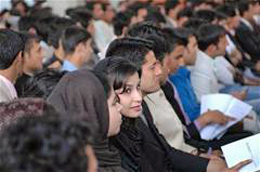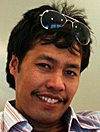
A USAID and Afghanistan National Assembly sponsored Youth Parliamentary session in June. (USAID photo)
 |
In Afghanistan, 'a generation of hope and change'
COMMENTARY | October 275, 2011
The Arab spring hasn’t gone unnoticed in Afghanistan. Young men and women there, using Facebook and Twitter, are launching an unprecedented movement for national unity, writes Nasim Ferat, a young Afghan now at school in the United States.
Part of a Nieman Watchdog series, 'Reporting the Endgame'
By Nasim Fekrat
fekratn@dickinson.edu
In some countries, young people have led in bringing change. In 2010, in Egypt and Tunisia, they toppled the government; in Iran, they have become the biggest and longest threat to the theocratic regime. In Iran, over 60 percent of the 75 million people in the country are under 30 years old. In Afghanistan, according to a United Nations report in 2008, 68 percent are under 25 years of age.
Traditionally, Afghan youth as a group have been quiet and never caused trouble. That may be changing. The Tunisian and Egyptian uprisings that spilled over to many other Arab countries have also inspired the Afghan youth.
Facebook and Twitter played a critical role in the Arab spring. Many Afghan young people were following the news of Arab uprisings carefully, and as regimes collapsed one after another, dozens of Facebook pages have sprung up calling for change in Afghanistan. A Facebook page like Love Afghanistan encourages Pashtun, Tajik, Hazara and Uzbek to unite. A similar page called "I love my glorious Afghanistan" promotes patriotism among its 9,000 members. The members debate questions like “when are we going to learn that unity is the only weapon to vanquish our enemies and is the best tool to make a better future for our Afghanistan?”
The new generation understands that Afghanistan has suffered from a lack of unity, a missing sense of “Afghanness,” a nationalistic feeling that could bring all ethnic groups together. For the first time in the history of Afghanistan, this feeling of unity and Afghanness is growing among its young generation. The significant point about these social media pages is that all these young people from different ethnic groups like Pashtun, Tajiks, Hazara and Uzbek are sharing ideas, and they debate issues related to national concerns.
In addition, and surprisingly, perhaps, Afghan females have a strong presence in these pages. Since the Taliban era, starting about 30 years ago, women, with few exceptions, have been kept in private with no chance to educate themselves, let alone get involved in politics.
Recently, however, a group of young women took to the streets of Kabul to pretest public sexual harassment. They have made a page called Young Women for Change in which they discuss and increase public awareness on gender issues, especially sexual harassment. Traditionally, men have made all decisions for women but today the young Afghan females are taking the lead to control their own fate.
These young men and women also share a global concern on environmental degradation. The Green Club is a voluntary group that engages in activities concerning environmental degradation and aims to promote a greener and cleaner environment for Afghan people. Besides raising awareness, they plant trees around Kabul, organizing public clean up and a cycling race for health and environmental issues.
The youth are also active in bringing reform in the government. For example a group called “Secularism for Afghanistan” believes that the only way to save Afghanistan is through a secular government. This group in its page has said that democracy is incomplete without having a secular government. (How unlike the Taliban is that!)
Today Facebook, Twitter and blogging are the most commonly used platforms for communicating and sharing information among youth. Afghanistan has a low literacy rate, with estimates ranging from 28 percent in a 2000 CIA census report to 35-40 percent in a 2007 Ministry of Education report. But young people are literate at a much higher rate than the rest of the population, and it is these young Afghans who make up the main work force in government, non-government organizations, and the private sector.
Digital social media have beome so widespread, in fact, that former President Rabbani, who was assassinated on September 20, publicly warned that “If the ulama do not play an effective role in the country, the situation will fall in the hands of the young Facebook and the Internet users.” (“Ulama” are Muslim clergy.)
Other Afghan leaders also are aware of these movements and see the possibility of events like those in Iran and other countries.
I have listed only a few examples of Facebook pages; there are dozens of similar ones, all run by young people. The new generation is technology-savvy and influenced by the world outside. It is calling for Afghan unity and changes to the country to catch up with the world. These are all new developments, nothing like them has happened the past. If the U.S and the international community want to bring changes to Afghanistan, they should focus on its youth. These young people will create trouble for the government, if not today, then before too long. These are the people who will lead Afghanistan in the future.
It is hard to exaggerate the potential. For the first time in the history of Afghanistan we are seeing Afghan young people so close to each other. The United States and the international community have poured billions of dollars into Afghanistan that ultimately went to the pockets of corrupted Afghan officials; they may now want to focus on its youth, the generation of hope and change who are the majority and the energy of the country.
|
|
Nasim Fekrat is a freelance Afghan journalist now studying and writing in the United States. 
|





